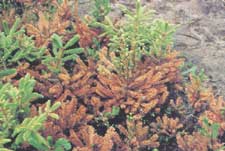Snow Blight of ConifersDarroll D. Skilling - Plant Pathologist, North Central Forest Experiment Station, USDA Forest Service, St. Paul, MN. Cordell C.E., Anderson R.L., Hoffard W.H., Landis T.D., Smith R.S. Jr., Toko H.V., 1989. Forest Nursery Pests. USDA Forest Service, Agriculture Handbook No. 680, 184 pp. Hosts Snow blight, caused by the fungi Phacidium abietis, Lophophacidium hyperboreum, Sorcotrochila piniperda, S. balsameae, and Hemiphacidium planum, affects Norway, white, black, blue, red, and Engelmann spruces: Douglas-fir: ponderosa, western white, and limber pines: and balsam, white, grand, and subalpine firs. Distribution Snow blight occurs wherever deep snow covers nursery beds for long periods in the North Central and Western United States and in Canada. The fungi causing this disease complex are apparently native to North America and are widely distributed in natural stands of spruce and fir. Damage Mild fungus infections kill only the foliage below the snow line, but severe infections kill large numbers of seedlings. Diagnosis
Biology Windborne spores, produced on infected needles, are discharged from the fruiting bodies during moist weather from late summer until winter. Tiny, drought-resistant microsclerotia are also produced on the surface of infected needles. The windborne spores and probably also the microsclerotia are the most important sources of new infections. The spores germinate on the needle surface as soon as the needles become embedded in snow. Needles of all ages are susceptible. Because the fungi can grow under a snow cover, seedlings that appear healthy in the fall may show severe browning or mortality the following spring. The fungus mycelium may also spread under the snow to adjacent foliage and enter healthy needles. Control Prevention - Snow blight may occur inconspicuously on the low branches of trees up to pole size and on spruces that are larger than pole size; therefore, such sources of inoculum near or within the nursery should be removed. Use northern seed sources, which are usually more resistant to these fungi than seed from southern areas. If possible, avoid nursery sites where snowmelt is delayed. Cultural - Avoid growing susceptible tree species in nursery beds where snow accumulates in drifts. Remove infected seedlings and adjacent, apparently healthy ones to reduce the spread of the disease from localized infections. Increase potassium fertilizer application where potassium is deficient because low potassium increases the severity of snow blight. Chemical - No fungicides are registered for control of snow blight. Selected References Bjorkman Erik. 1963. Snow blight of pines In: Internationally dangerous forest tree diseases. Misc. Pub). 939. Washington. DC: U.S. Department of Agriculture: 70-72. Reid, James; Cain. R.F. 1962. Studies on the organisms associated with "snow blight" of conifers in North America. II. Some species of the genera Phacidium, Lophophacidium, Sarcotrichila. and Hemiphacidium. Mycologia. 54: 481-497. Shilling. Darroll D. 1975. Snow blight of conifers. In: Peterson. Glenn W.: Smith, Richard S., Jr., tech. coords. Forest nursery diseases in the United States. Agric. Handb. 470. Washington. DC: U.S. Department of Agriculture. 85-87. |
Forest Pests: Insects, Diseases & Other Damage Agents |

|
|


